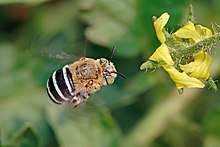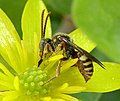Apidae
The apids (Apidae ) are a family of apocrite Hymenoptera; They constitute a large group of bees that includes the honey or domestic bee (the best known), stingless bees, orchid bees, parasitic bees, bumblebees and carpenter bumblebees, as well as other lesser-known groups.
Biology
Many are social bees, especially those of the Apinae subfamily, but others are solitary bees and some are parasitic, meaning they lay their eggs in the nests of other bees. Social behavior seems to have evolved independently in more than one group. In bee societies there are different castes, with a queen (or queens) that is dedicated to reproduction and numerous non-reproductive workers, who do all the maintenance tasks of the nest. In addition there are the males or drones.
There are examples of different degrees of sociality in different species. Apis mellifera is an example of eusociality, that is, of the most advanced degree of sociality with permanent colonies. Others, like bumblebees, present a less complex degree of sociality with a queen starting a new colony every year.
All non-parasitic species and especially eusocial ones are excellent pollinators because they visit numerous flowers when they collect nectar and pollen.
Taxonomy
The taxonomy has been modified and there is still no complete agreement on the classification. Previously only bees related to the honey bee, bumblebees and orchid bees were considered members of this family but now also includes all bees formerly in the family Anthoporidae (tribe Anthophorini), parasitic bees, carpenter bumblebees and others. It is estimated that there are more than 5,750 in more than 200 genera in the world.
Subfamilies
Apinae
The subfamily Apinae includes honey bees, bumblebees, stingless bees, orchid bees, Anthophorini, and others. Contains twenty tribes. Most species are solitary and build simple nests underground. Honey bees, stingless bees, and bumblebees, on the other hand, are eusocial or colonial. Eusociality is thought to have evolved independently more than once. These groups differ in characteristics such as their way of communication between workers and construction of the nest. Worldwide there are more than 3,500 species in about 160 genera in 20 tribes.
Tribes:
- Ancylaini
- Anthophorini
- Apini
- Bombini
- Centridini
- Emphorini—(Subtribu Ancyloscelidina; Subtribu Emphorina)
- Ericrocidini
- Eucerini
- Euglossini
- Exomalopsini
- Isepeolini
- Melectini
- Meliponini
- Osirini
- Protepeolini
Nomadinae
The subfamily Nomadinae, or cuckoo bees, has 32 genera in 10 tribes. They are all kleptoparasites of the nests of other bees.
Tribes:
- Ammobatini
- Ammobatoidini
- Biastini
- Brachynomadini
- Caenoprosopidini
- Epeolini—(Epeoline Subtribution; Odyneropsin Subtribu; Thalestriin Subtribu)
- Hexepeolini
- Neolarrini
- Nomadini (see Nomad)
- Townsendiellini
Xylocopinae
The subfamily Xylocopinae includes carpenter bees. They are generally solitary, although they tend to build their nests in close proximity to others (gregarious). Some subgroups like Allodapini include some eusocial species. Most build nests in plant stems or wood. There are 16 genera in four tribes and one fossil tribe.
Tribes:
- Allodapini
- Boreallodapini †
- Ceratinini (see: Ceratina)
- Manueliini
- Xylocopini
Evolution
The oldest fossils in this family date from the early Cretaceous. The oldest specimen is Cretotrigona prisca from the Cretaceous of New Jersey. The diversity of Apidae and other bee families is thought to have increased significantly with the increase in angiosperm diversity that took place in the Cretaceous. Some more recent fossils are Protohabropoda pauli from the Late Oligocene of Europe, the bumblebee Bombus cerdanyensis from the Late Miocene, Apis nearctica from the Middle Miocene of North America and Euglossopteryx (with a single species E. biesmeijeri) from the middle Eocene.
Gallery
Contenido relacionado
Dybowskia
Vibrio cholerae
Roemeria hybrida












